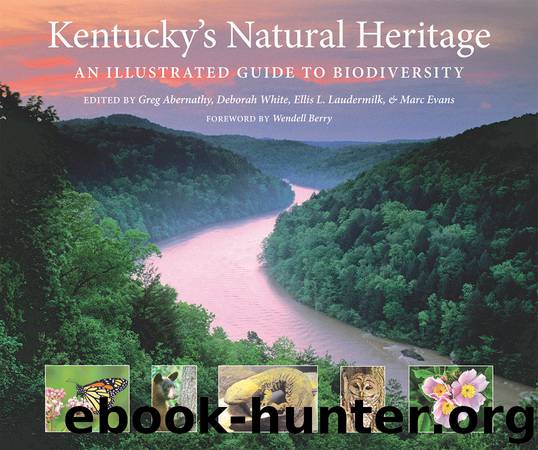Kentucky's Natural Heritage by Greg Abernathy & Deborah White & Ellis L. Laudermilk & Marc Evans

Author:Greg Abernathy & Deborah White & Ellis L. Laudermilk & Marc Evans
Language: eng
Format: epub
Publisher: The University Press of Kentucky
Published: 2010-04-08T04:00:00+00:00
Fields planted in corn under conventional tillage are particularly susceptible to erosion during rainfall events. This not only results in the loss of valuable topsoil; it also degrades water quality when runoff transports large amounts of sediment, nutrients, and pesticides into streams. Tim McCabe, USDA Natural Resources Conservation Service; courtesy of U.S. Fish & Wildlife Service Digital Library System
Engineering advances, such as the John Deere steel plow in the 1830s, resulted in the conversion of additional natural areas to agriculture. Industrial agriculture began in earnest in the mid-1900s when advances in machinery production, fertilizers, and chemicals became available to farmers. In the 1970s, the belief that the world’s ability to supply food would fall short of the projected need resulted in rapid expansion of U.S. food production and exports. Remnant natural areas were further reduced as more land was converted to row-crop farming. In western Kentucky channelization and drainage projects severely affected wetlands such as the extensive bottomlands in the Mayfield Creek and Bayou de Chien watersheds. These changes are typical of wetland conversion in other areas of the state.
Download
This site does not store any files on its server. We only index and link to content provided by other sites. Please contact the content providers to delete copyright contents if any and email us, we'll remove relevant links or contents immediately.
| Africa | Americas |
| Arctic & Antarctica | Asia |
| Australia & Oceania | Europe |
| Middle East | Russia |
| United States | World |
| Ancient Civilizations | Military |
| Historical Study & Educational Resources |
Cat's cradle by Kurt Vonnegut(14763)
Pimp by Iceberg Slim(13781)
Underground: A Human History of the Worlds Beneath Our Feet by Will Hunt(11840)
4 3 2 1: A Novel by Paul Auster(11794)
The Radium Girls by Kate Moore(11624)
Wiseguy by Nicholas Pileggi(5320)
American History Stories, Volume III (Yesterday's Classics) by Pratt Mara L(5138)
Perfect Rhythm by Jae(5074)
The Fire Next Time by James Baldwin(5021)
Paper Towns by Green John(4803)
Pale Blue Dot by Carl Sagan(4620)
A Higher Loyalty: Truth, Lies, and Leadership by James Comey(4554)
The Mayflower and the Pilgrims' New World by Nathaniel Philbrick(4283)
The Doomsday Machine by Daniel Ellsberg(4248)
Killers of the Flower Moon: The Osage Murders and the Birth of the FBI by David Grann(4191)
Too Much and Not the Mood by Durga Chew-Bose(4096)
The Sympathizer by Viet Thanh Nguyen(4096)
The Borden Murders by Sarah Miller(4021)
Sticky Fingers by Joe Hagan(3913)
